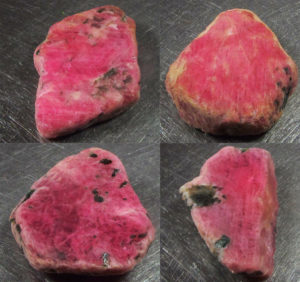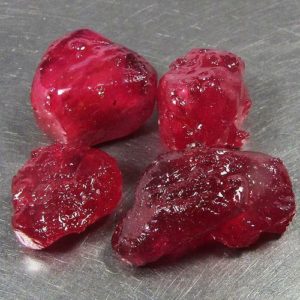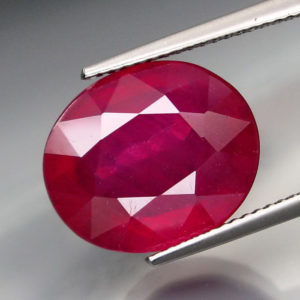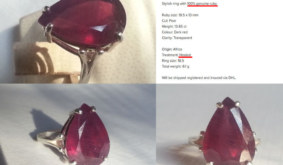You might wonder why glass-filled rubies are a perfect waste of money. Before I answer this question, let me ask you another one. Have you bought a piece of jewelry with ruby or rubies after 2004? If yes, it might be the case that you are one of those buyers who has wasted a few hundred or a few thousand dollars/euro.
So, why is it a perfect waste of money? There are three main problems with glass-filled rubies, also known as composite rubies. First, they have truly serious durability issues: they can get damaged by the most common household cleaning products as bleach and different cleaners, even lemon juice. Second, it is impossible to tell what proportion of your ruby is really ruby and what proportion of it is worthless glass. Third, the starting material is of very low quality, therefore – cheap.
However, here comes the surprise: when I say it is a perfect waste of money, I do not refer to any of the above problems. If you are aware that what you buy is a glass-filled ruby, you know its true market value, and you pay an adequate price for it, I see no problem in glass-filled rubies. I believe they have their rightful place on the market.
The problem, the true problem is that too many sellers are taking advantage of unknowing buyers and selling lead glass-filled rubies (both loose and set in pieces of jewelry) as the real thing, at prices way above what would be reasonable.
So, if you want to find out more about why lead glass-filled rubies are nearly worthless, how they are made, and what are their durability challenges, keep on reading.
If you want to see some real-life examples of how sellers dupe their buyers and how you can identify composite rubies without professional equipment, skip to this article.
What is a Lead Glass-Filled Ruby?
Lead glass-filled rubies first appeared on the market in 2004. According to the Gemological Institute of America (GIA), “the GAAJ laboratory in Japan issued a lab alert about rubies they had seen that had large numbers of fractures filled with high-lead-content glass, which made them appear very transparent. Since then, large quantities of this material have reached international markets.”
The starting material is of very low quality: opaque, industrial-grade stones, rather brownish than red. Until lead glass-filling was introduced, such material could be used as mineral specimens only. It could not be used even for cheap fashion or costume jewelry.
So, this low-quality corundum, which has an enormous amount of fractures and cavities, is mixed with powders that are composed primarily of lead and silica but may also contain other ingredients, such as copper or bismuth. This mixture is heated fusing the powders into a lead glass that penetrates the fractures and cavities in the stone.
According to GIA, “The effectiveness of the treatment is amazing, in that it transforms corundum that is opaque and nearly worthless into material that is transparent enough for use in jewelry.”
Indeed, lead glass-filled rubies can seem very appealing to an untutored buyer.
Untreated vs. Heated vs. Glass-Filled
Sellers may use different terminology to describe their products, but the fact is that as far as rubies are concerned you will come across one of the following: untreated rubies, heated rubies, and lead glass-filled rubies. So, what’s the difference?
Needless to say, untreated rubies (commonly referred to as “unheated rubies”) are the rarest and most valuable. According to some reasonably reliable sources, untreated rubies account for about 1-2% of all rubies on the market.
Heating or heat treatment is a widely used and accepted treatment method for rubies in the gem and jewelry industry. Ruby is heated to improve its clarity and color. These gemstones are still natural and they do not require special care. Such treatment is permanent and does not degrade over time. It would be wrong to claim that heating necessarily diminishes ruby’s value: an excellent quality heated ruby can easily cost more than an untreated ruby of inferior quality.
With lead glass-filled rubies the problem is that it cannot be easily determined where the lead glass ends and the ruby begins. It is impossible to determine what proportion of a ruby is actually lead glass without dissolving the filler.
Lab tests reveal that lead glass can account for as much as 60% of the stone’s weight. This is exactly the reason why GIA, for instance, does not consider lead glass-filling as a treatment any longer. They would label these rubies as “a manufactured product” in their certificates. Many other respected gemstone labs refer to them as a “composite ruby”.
Lead Glass-Filled Ruby: Practical Implications
As far as jewelry repair procedures are concerned, according to GIA, “No damage to the lead-glass fillings was observed with standard steam cleaning, ultrasonic cleaning, setting, and even retipping of prongs, when these procedures were performed carefully… Some damage was seen with immersion in a pickling solution and exposure to other reagents.”
The main problems, however, are related to everyday wear. Lead glass is a substance by far not as hard as ruby itself. Therefore, a lead glass-filled ruby is substantially more susceptible to scratching, nicking, and fracturing.
Composite rubies can get damaged easily by such household cleaning products as bleach as well as products containing ammonia, including oven and drain cleaners, glass and window cleaners, toilet cleansers, floor polishing waxes, furniture polish, stainless-steel cleaners, and multipurpose cleaners. Contact with lemon juice is also highly likely to damage a composite ruby.
All of the above substances would etch the glass component of a composite ruby, thus revealing the stone’s fractures (visible as ugly lines crisscrossing the surface of the stone). Once damaged, these composite rubies cannot be repaired by a jeweler. Needless to say, the above substances normally would do no harm to a natural ruby no matter heated or untreated.
The Value
There are several aspects that have a negative effect on the value of composite rubies. One, obviously, is the aforementioned fact that a substantial part of a lead glass-filled ruby is composed of worthless glass, and it is uneasy to determine exactly what proportion is natural corundum and what proportion is glass. The other is that the starting material is of such low quality.
It has also to be taken into account that lead glass has a refractive index (RI) very close to that of a ruby. Therefore, it is very difficult to judge the stone’s clarity for grading purposes accurately.
Combine that with composite ruby’s increased fragility and the issues with household cleaning products, and you get a nice, shiny stone that is worth next to nothing.
Most of the sources I have found claim lead glass-filled rubies cost between $10 and $30 per carat (the sources being gemologists and other experts, not composite ruby sellers). This might seem very cheap, especially when compared to natural rubies that would normally cost hundreds to thousands of dollars per carat.
However, I regard this price as an insanely high estimate. I am truly sorry for anyone who has paid such a price for a composite ruby. I have never bought a composite ruby at a price higher than $3 per carat (and I am not talking about bulk purchasing here). A few real-life examples:
13.3 carat stone – $2.18 per carat;
5.99 carat stone – $1.25 per carat;
1.85 carat stone – $1.22 per carat.
Visually they all were nice-looking stones.
As GIA put it, “Inexpensive synthetics cost more than this.” I have no choice but to agree.
If you have bought a piece of jewelry with ruby or rubies after 2004, please share your experience in the comments section below. Our community appreciates you sharing your experience!



